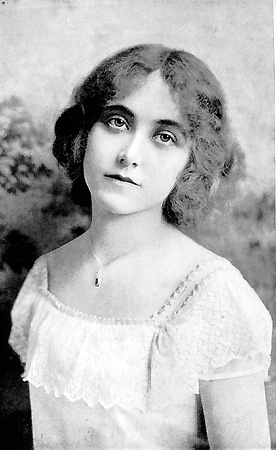 Volume III: Biographies
Volume III: Biographies Volume III: Biographies
Volume III: Biographies

Francelia Billington, from The Photoplay Magazine, August 1913. Courtesy of Robert S. Blanchard (P-30)
Thanhouser Career Synopsis: Francelia Billington was an actress with Thanhouser for a brief time in early 1913.
Biographical Notes: Francelia Billington was born in Dallas, Texas on February 1, 1895, the daughter of Adelaide Bueter, an American, and James Billington, an Englishman. When she was 10 she moved to Los Angeles, where she was educated at the Sacred Heart Convent. She was "discovered" for films by George Melford and became Carlyle Blackwell's leading lady at Kalem in 1912. When Alice Joyce went to Kalem's New York studio, Miss Billington was tapped to take her place at Kalem's Glendale, California studio. The actress was seen in A Dangerous Wager, The Boomerang, The Usurer, The Pride of Angry Bear, and other pictures. While with Kalem she received publicity in The Motion Picture Story Magazine and elsewhere. She then went to The New York Motion Picture Company for a brief stint, possibly for only a few weeks.
Her first motion picture work for Thanhouser was in 1913, when she joined their West Coast company early in the year. She played minor parts and received no special attention until Louis Reeves Harrison, a reviewer and columnist for The Moving Picture World, noticed her brief appearance in the Thanhouser production of Carmen, asked her name, and reported to his readers in the May 10, 1913 issue that a Miss "Billings" acted superbly, if even for just an instant on the screen.
The article was seen by Charles J. Hite, who properly identified her as Francelia Billington. When Thanhouser's West Coast stock company went back to the East on April 30, 1913, Francelia Billington remained behind and joined Majestic, also controlled by Hite, which took over the former Thanhouser studio. In what was called the "New Majestic," Miss Billington was one of three stars featured at the outset, together with William Garwood (a Thanhouser veteran) and Fred Mace (a comedian).
The Moving Picture World, July 18, 1914, told of the actress: "Francelia Billington, who plays leads in the Reliance Mutual movies, has attained considerable versatility in her 19 years. In addition to her ability to portray comedy as well as emotional roles she can take her place at the camera, focus it and turn the crank with the skill and precision of an old operator. Her interest in photography, which takes up most of her spare time and considerable of her money, was responsible for her learning to operate a motion picture camera. She not only handles the camera but she has a darkroom in her home where she develops her negatives and makes her own prints. It was a natural step from the still camera to the motion picture machine.
"Miss Billington began her career as a movie actress as the result of a joke. She appeared in minor roles with a small concern in California [apparently Kalem, which was a larger company than Thanhouser! - Ed.], where she chanced to be seen by a representative of the Thanhouser company, who caused her to be engaged. After a stay with the Thanhouser she was transferred to the Majestic and later to the Reliance. Nature was kind to Miss Billington and she was apparently intended to play romantic roles. She is tall and lithe and her personal charms have caused her to be known as 'The Beauty of the Screen.' If the silent drama ever loses her it will because she decides to use her fine lyric soprano voice. Her mother is one of the leading musicians in Los Angeles, and the daughter has been trained in music by her mother."
Miss Billington remained with Majestic on the Mutual Program and appeared in such films as Strathmore, Child of God, Bettina Loved a Soldier, and numerous others, after which she went to Mutual's Reliance division (Children of the Sea, 1915), then to Universal by early 1916 (The Iron Grip of Crime, Red Feather, Heart Strings, The Black Sheep of the Family, etc.), and, in December 1916, to American ("Flying A") in Santa Barbara, California, where she played in support of William Russell and others (Shackles of Truth, The Frame-Up, Periwinkle, His Arabian Night, The Fighting Gentleman, A Son of Battle, Sands of Sacrifice, The Masked Heart, High Play, etc.).
The 1916 edition of the Motion Picture News Studio Directory stated that she was 5'7" tall, weighed 130 pounds, and had a light complexion, brown hair, and gray eyes. At the time Miss Billington was with Universal, and her home address was 1227 Chestnut Street, Glendale, California. Her favorite pastimes included horseback riding and music. A surviving letter in her hand indicates that spelling wasn't her forte, and that she had trouble even with simple words.
An article in The Moving Picture World, December 30, 1916, noted that she: "has dark brown hair, large gray eyes fringed with long, dark, shading lashes, a perfect complexion, and an extraordinary command of facial expression. She has the indefinable quality known as 'atmosphere.'" Later, she appeared opposite Lester Cuneo in a series of independent films, and married him in 1920, a union which ended in divorce on October 30, 1925. Two days later, Cuneo committed suicide. After then, Francelia Billington faded from the motion picture scene.
Among the actress' other films of the late teens and early 1920s were The Terror (Red Film, 1917), Blue Blazes (Russell-Griever, 1918), Blind Husbands (Universal, 1919), The Heart of a Gypsy (Hallmark, 1919), Wit Wins (Hallmark, 1919), Desert Love (Fox, 1920), The Great Air Robbery (Universal, 1920), The Day She Paid (Universal, 1920), The Ranger and the Law (Capitol, 1920), and Blazing Arrows (Apollo, 1922). She died of tuberculosis in Glendale, California on November 24, 1934.
Thanhouser Filmography:
1913: The Widow's Stratagem (5-2-1913), Carmen (5-27-1913)
# # #
Copyright © 1995 Q. David Bowers. All Rights Reserved.